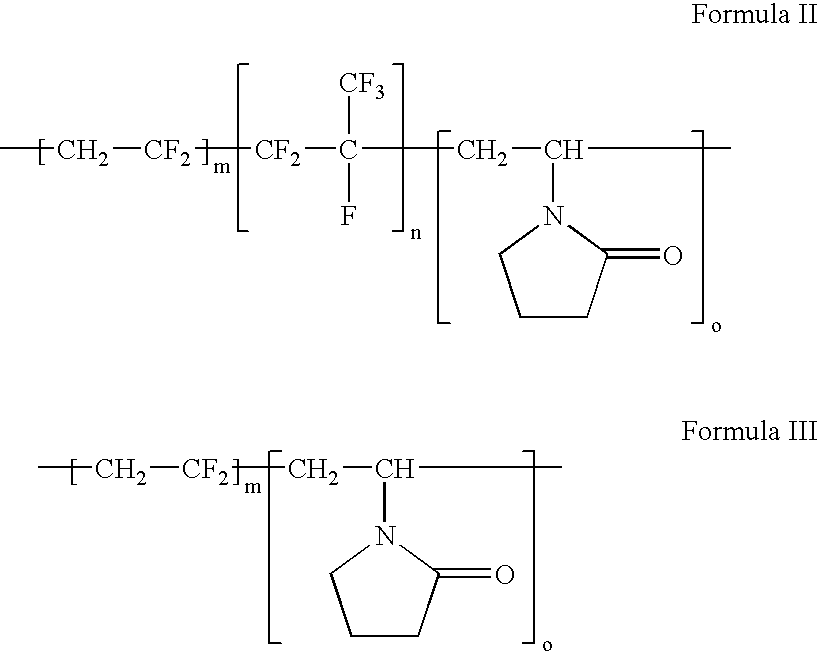Polymers of fluorinated monomers and hydrophilic monomers
a technology of fluorinated monomers and polymers, applied in the field of polymer materials, can solve the problems of low tsub>g/sub>, stent thrombosis remains, and chronic restnosis, and achieve the effects of mechanical strength and/or flexibility, biocompatibility, and physiologic durablity of the polymer
- Summary
- Abstract
- Description
- Claims
- Application Information
AI Technical Summary
Benefits of technology
Problems solved by technology
Method used
Image
Examples
example 1
Synthesis of poly(vinylidene fluoride-co-hexafluoropropylene-co-vinyl pyrrolidone), 80 / 15 / 5 molar ratio
[0043] A 20 gallon glass lined autoclave is filled with 11 gallons of deionized water, and then sparged with nitrogen to remove oxygen. The autoclaved is then charged with 3.47 kg of vinylidene fluoride (VDF) and 1.53 Kg of hexafluoropropylene (HFP). 40 g of a 70% solution of tertiary butyl hydroperoxide in water is diluted to 250 ml with deionized water. 31 g of sodium metabisulfite and 6.3 g of ferrous sulfate heptahydrate is diluted to 250 ml with deionized water. These two solutions are added separately to the autoclave over a ten period time period. The autoclave is maintained throughout the entire polymerization between 15-25° C. After 30 minutes into the polymerization, vinyl pyrrolidone is pumped into the autoclave. After consumption of the initial charge of VDF and HFP, VDF and HFP are added to the autoclave at the stoichiometric ratio to maintain a reactor pressure of 50...
example 2
Synthesis of poly(vinylidene fluoride-co-hexafluoropropene-co-vinyl pyrrolidone), molar ratio 80 / 18 / 2 by atom transfer polymerization
[0044] To a 2.5 gallon stainless steel autoclave equipped with agitation is added copper bromide (28 g, 0.195 mole), 2,2′-bipyridine (60.9 g, 0.39 mole), and 1,2-diiodoethane (55 g, 0.195 mole). The autoclave is purged with argon to remove all oxygen. CO2 is introduced to reach a pressure of 1200 psig and the autoclave thermostated to ambient temperature. The autoclave is then charged with 1 kg of VDF and 528 g of HFP. The temperature is raised to 40° C. and the reaction allowed to proceed for 20 hours. Vinyl pyrrolidone is added (43.4 g) and the polymerization allowed to proceed for 11 more hours. After venting the autoclave the polymer is dissolved in 5 liters of acetone and then isolated by precipitation into methanol.
example 3
Preparation of a Drug Eluting Stent Coating Using the Polymer of Example 1
[0045] A polymer solution containing between about 0.1 mass % and about 15 mass %, for example, about 2.0 mass % of PBMA and the balance, a solvent mixture of acetone and cyclohexanone, the solvent mixture containing about 60 mass % of acetone and about 40 mass % of xylene is prepared. The solution is applied onto a stent to form a primer layer. To apply the primer layer, a spray apparatus, such as an EFD 780S spray nozzle with a VALVEMATE 7040 control system (manufactured by EFD, Inc. of East Providence, R.I.) can be used. The EFD 780S spray nozzle is an air-assisted external mixing atomizer. The composition is atomized by air and applied to the stent surfaces. During the process of applying the composition, the stent can be optionally rotated about its longitudinal axis, at a speed of 50 to about 150 rpm. The stent can also be linearly moved along the same axis during the application.
[0046] The poly(butyl ...
PUM
| Property | Measurement | Unit |
|---|---|---|
| pressure | aaaaa | aaaaa |
| pressure | aaaaa | aaaaa |
| temperature | aaaaa | aaaaa |
Abstract
Description
Claims
Application Information
 Login to View More
Login to View More - R&D
- Intellectual Property
- Life Sciences
- Materials
- Tech Scout
- Unparalleled Data Quality
- Higher Quality Content
- 60% Fewer Hallucinations
Browse by: Latest US Patents, China's latest patents, Technical Efficacy Thesaurus, Application Domain, Technology Topic, Popular Technical Reports.
© 2025 PatSnap. All rights reserved.Legal|Privacy policy|Modern Slavery Act Transparency Statement|Sitemap|About US| Contact US: help@patsnap.com



